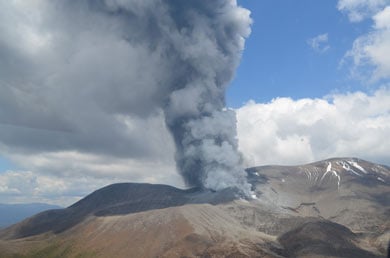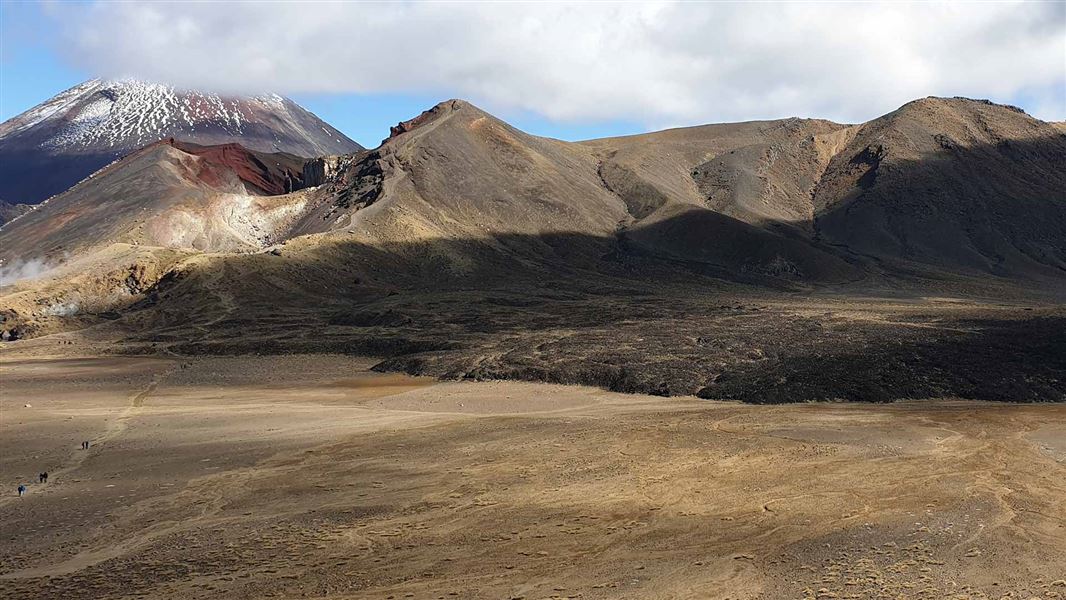Where DOC manages volcanic risk
There are three visitor-accessible volcanoes on public conservation land that have active or recently active volcanic vents. All three are in Tongariro National Park:
- Mount Ngāuruhoe – last erupted in 1977
- Mount Ruapehu – last erupted in 2007
- Mount Tongariro – last erupted in 2012
The only other volcano with a recently active vent on land managed by DOC is Raoul Island, which is not accessible to the public. This volcano last erupted in 2006.
How we manage volcanic risk
DOC manages volcanic risk through its volcanic risk management guidelines.
Using these guidelines, DOC manages proximity to potential eruption sources (hazard exposure) as volcanic unrest (risk) increases. Our management actions are mostly triggered by Volcanic Alert Level (VAL) changes. We will also make decisions on access based on other inputs from GNS Science and risk assessments.
The Volcanic risk management at Mt Ruapehu map (PDF, 21,254K) shows how visitor proximity to the Crater Lake vent is managed as volcanic unrest (risk) increases.
Volcanoes are incredible and volatile forces of nature. It’s important to recognise that despite DOC having a robust volcanic risk management system in place, people's safety can never be guaranteed when close to an active volcanic vent.
A significant part of DOC's risk management work is notifying the public of the risk so people can make decisions on the level of risk they're willing to accept.
New Zealand Volcanic Alert Level (VALs)
VALs define the current status of New Zealand's volcanoes. There are six levels, ranging from no volcanic unrest, through two levels of volcanic unrest, to three levels of volcanic eruption.
| VAL | Volcanic activity | Most likely hazards | |
|---|---|---|---|
| Eruption | 5 | Major volcanic eruption | Eruption hazards on and beyond volcano* |
| Eruption | 4 | Moderate volcanic eruption | Eruption hazards on and near volcano* |
| Eruption | 3 | Minor volcanic eruption | Eruption hazards near vent* |
| Unrest | 2 | Moderate to heightened volcanic unrest | Volcanic unrest hazards, potential for eruption hazards |
| Unrest | 1 | Minor volcanic unrest | Volcanic unrest hazards |
| 0 | No volcanic unrest | Volcanic environment hazards | |
VALs do not forecast future activity. They provide an assessment of a volcano’s level of unrest at the time the alert level is applied and communicated.
How the Tongariro National Park Volcanic Alert Network operates
Part of our risk management toolbox is the Volcanic Alert Network. These are warning systems which provide an additional layer of protection for life safety on the volcanoes.
The four systems of the Volcanic Alert Network are:
1. Tongariro Eruption Detection System (TEDS)
-
Detects eruptions on the Tongariro Volcanic Massif using acoustic and seismic sensors located on the flanks of the volcano. The system does not generate a public warning – it only communicates with DOC and GNS.
-
It is part of the GeoNet project and is managed by GNS Science.
2. Ruapehu Eruption Detection System (REDS)
-
Detects eruptions from the active crater of Mt Ruapehu – Te Wai ā-moe/Crater Lake – using acoustic and seismic sensors located on the flanks of the volcano.
-
It is part of the GeoNet project and is managed by GNS Science.
3. Whakapapa Ski Area Lahar Alert and Warning System (WLAWS)
-
If an eruption is detected by REDS, WLAWS produces a siren and voice message warning in at-risk sections of Whakapapa Ski Area, signalling people to move out of lahar paths to higher ground.
-
The system also triggers alerts to response agencies and affected stakeholders.
-
WLAWS is the primary management tool to reduce life and safety risk in Whakapapa Ski Area from sudden onset volcanic eruptions.
-
It is owned and operated by DOC.
4. Whakapapa Village Lahar Alert and Warning System (VLAWS)
-
VLAWS uses a lahar fence (tripwire) in Skippers Canyon on Mt Ruapehu to detect lahars travelling down the Whakapapanui Stream.
-
The system is primed by REDS and will not activate without an eruption being detected.
-
If triggered it produces a siren and voice message warning, signalling people to move out of at-risk areas in Whakapapa Village to designated evacuation points.
-
It is owned and operated by DOC.
What to do in the event of an eruption
Changes after the 2012 Te Maari eruptions

Te Maari erupting on 21 November 2012 – the lesson was the need to be decisive
Image: Craig Miller, GNS Science ©
The lesson from the Te Maari eruptions in August and November 2012 was the need to be decisive in managing increasing unrest at any of the three main vents – Ngāuruhoe, Red Crater and Te Maari.
Our methodology for managing volcanic risk on the Tongariro Alpine Crossing and Tongariro Northern Circuit is identifying closure points based on the GeoNet Volcanic Alert Levels (VAL).
Tongariro and Ngāuruhoe typically sit at VAL 0 (no volcanic unrest). When the VAL increases to 1 (minor volcanic unrest) we close the track and assess.
The length of this initial VAL 1 closure period is dictated by the data available, risk assessments and input from GNS and/or other subject matter experts. If DOC is confident that the probability of eruption is low, and the level of risk is tolerable, then the track is reopened.
At VAL 2 and above, the track is closed until the activity has deescalated to VAL 1 or VAL 0. Again, the assessment to reopen would involve risk assessments and expert input.
Changes since the 2019 Whakaari eruption
The management of volcanic risk has not materially changed since the Whakaari eruption.
DOC has well established systems to manage risk that have improved over decades, learning from the multitude of eruptions that have occurred in Tongariro National Park.
Our documentation is always evolving, and our practices are subject to change as improvements are identified, and progress is made in the fields of earth science and risk management.
Our current approach incorporates the consideration of eruption probability but recognises that the most robust mechanism we have to trigger management action is Volcanic Alert Levels.
